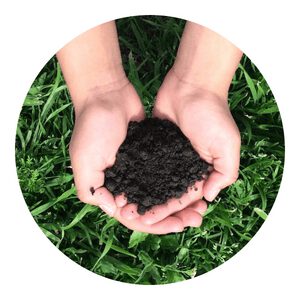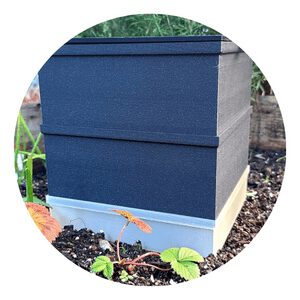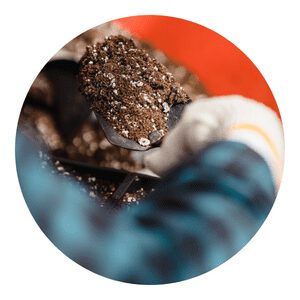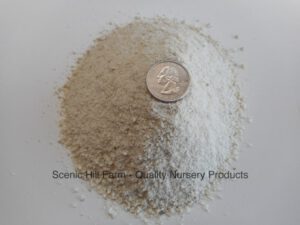How to grow organic strawberries
Organic strawberries are not only delicious, but they are also packed with nutrients and antioxidants that can have various health benefits.
One of the main benefits of eating organic strawberries is that they can help improve heart health.
This is due to the presence of compounds like ellagic acid and anthocyanins, which can help lower bad cholesterol levels and reduce inflammation.
Additionally, strawberries are a good source of Vitamin C, which can help keep blood vessels healthy and prevent stroke.
Strawberry
Chappy the Gardener, everyone’s favorite gardening expert, is back with his top tips for growing organic strawberries.
This year, don’t miss out on the deliciousness of fresh, organic strawberries – follow Chappy’s tips and you’ll be sure to have a bumper crop!
What do you need to grow organic strawberries?
In order to grow organic strawberries, you will need soil, mulch, compost, a pH meter, and a watering can.
The soil should be light and fluffy with plenty of organic matter.
Strawberries prefer a pH of 6.0-6.8. You can adjust the pH of your soil by adding lime or sulfur. Mulch helps to keep the soil moist and cool while also suppressing weed growth.
Compost provides essential nutrients for the plants.
A pH meter can help you determine whether the soil is at the desired pH level. The plants should be watered regularly, but be careful not to overwater them as this can cause root rot.
The best time to plant strawberries
When it comes to planting strawberries, the best time of year to do it depends on where you live.
For most of the United States, late winter or early spring is the best time to plant strawberries.
This is because they need plenty of time to grow before the hot summer weather arrives.
If you live in a warm climate, though, you can plant them later in the spring or even in the summer.
Just make sure there is plenty of water available so they can stay hydrated.
Strawberry planting tips
When planting strawberries, one of the most important things to keep in mind is soil preparation.
Strawberries like a slightly acidic soil with a pH of 6.0-6.5.
If your soil is not within that range, you can adjust it by adding sulfur or aluminum sulfate to the soil before planting.
Another key factor in strawberry planting is choosing the right location.
The plants need plenty of sunlight (at least six hours per day) and good air circulation. They should also be planted where they will get some shelter from the wind.
The third thing to consider when planting strawberries is spacing.
You’ll want to plant them 18-24 inches apart in rows that are 3 feet apart. This will give them enough room to grow without competing for space and produce a good crop yield.
Care and feeding of strawberry plants
Strawberry plants are one of the easiest fruits to grow organically. With a little care and attention, you can have a bumper crop of strawberries to enjoy all summer long.
Here are a few tips on how to care for your strawberry plants:
Watering: Strawberry plants need about 1-2 inches of water per week. Water early in the day so that the leaves have time to dry out before nightfall.
This will help prevent diseases such as gray mold from developing.
Fertilizing: Apply a organic fertilizer once a month.
You can also use compost or manure to fertilize your strawberry plants. Apply these organic amendments at the rate of 1 pound per square foot of bed area.
Mulching: Mulch your strawberry plants with straw, pine needles, or black plastic.
Harvesting organic strawberries
Organic strawberries are a great choice for people looking to buy produce that is grown without the use of pesticides or other chemicals.
When harvested properly, organic strawberries can be just as sweet and juicy as conventionally-grown berries.
Here are some tips for harvesting organic strawberries:
1. Choose berries that are fully ripe; they will be a deep red or pink color and will have a sweet smell.
2. Don’t harvest any berries that are soft or have mold on them.
3. Use a sharp knife or scissors to cut off the stem, being careful not to damage the berry itself.
4. Store the strawberries in the fridge in a container with a lid; they should last for about 2-3 days.
How to grow strawberries hydroponically
Hydroponic strawberry production is becoming more popular each year due to the high demand for fresh strawberries.
In hydroponics, plants are grown in water without soil. This method has several advantages over traditional soil-based production, including: greater control over the environment, lower water requirements, and higher yields.
To get started in hydroponic strawberry production, you will need to choose a growing system.
There are many different types of systems available, so you should choose one that fits your needs and budget.
The most common types of systems are drip systems and ebb and flow systems.
Once you have selected a growing system, you will need to choose a strawberry variety that is suited for hydroponics.
There are many different varieties available, so be sure to research which ones will work best for your climate and growing conditions.
You will need at least eight strawberry plants per family. This will give you enough berries to enjoy fresh strawberries throughout the growing season and also have some to preserve for later.
Chappy The Gardener
How long do strawberries take to grow in hydroponics?
A lot of people are interested in growing their own food these days, and strawberries are a popular choice.
They’re relatively easy to grow, and they don’t take up a lot of space. But how long do they take to grow?
If you’re growing strawberries in hydroponics, you can expect them to take about 30 days from transplanting to harvest.
This is much faster than if you were growing them in soil, where it would take closer to 60-90 days.
The main reason for this difference is that hydroponics allows the roots to access oxygen more easily, which speeds up growth.
So if you’re looking to get your strawberry fix more quickly, hydroponics is the way to go.
Just be prepared to put in a little bit of work up front to get your system set up.
Do hydroponic strawberries taste better?
When it comes to the flavor of hydroponic strawberries, many people believe that they are sweeter and more intense than those grown in soil.
While there is no scientific evidence to support this claim, it is believed by many growers that the lack of soil allows the plants to focus their energy on producing fruit, resulting in a tastier berry.
In addition, hydroponic strawberries are typically picked at the peak of ripeness, when they are most flavorful, while those grown in soil may be picked before or after this point.
How to grow strawberries aquaponics
Aquaponics is an excellent way to grow organic strawberries.
The system recycles water from a fish tank through a hydroponic growing bed, providing nutrients for the plants and cleaning the water for the fish.
Aquaponics is easy to set up and maintain, and can be done on a small or large scale.
To get started, you will need:
A fish tank
A hydroponic growing bed
Pump
Grow lights (if not using a sunny windowsill)
Strawberry plants
Set up your fish tank according to the manufacturer’s instructions.
Fill the tank with water and add your chosen fish. Common choices include tilapia, catfish, and trout.
Allow the tank to cycle for several weeks before adding plants.
While your fish are getting acclimated, set up your hydroponic growing bed.
Do strawberries grow good in a greenhouse?
Yes, strawberries can grow well in a greenhouse.
A greenhouse protects strawberry plants from cold weather and pests, and can provide the warm temperatures that strawberries need to thrive.
Strawberry plants will need to be well-ventilated to prevent mold and mildew from growing on the fruits.
How long does it take to grow strawberries in a greenhouse?
Organic strawberries can be grown year-round in a greenhouse, with the peak season being from late winter to early spring.
Depending on the climate, it can take anywhere from 45 to 60 days for the strawberries to mature and be ready for harvest.
In order to ensure a bountiful crop, it is important to start with healthy plants that are resistant to disease.
The plants should also be given enough space to grow and receive adequate ventilation and sunlight.
What are the best strawberries to grow in a greenhouse?
When most people think of strawberries, they think of a juicy, red fruit that’s perfect for eating fresh or adding to desserts.
But did you know that there are actually many different types of strawberries?
And some varieties are better suited for growing in a greenhouse than others.
If you’re interested in growing strawberries in a greenhouse, here are some of the best varieties to consider:
Alpine Strawberries: These small but mighty berries are perfect for growing in containers or hanging baskets. They have a delicate flavor that is often described as “fruity” or “sweet.”
Chandler Strawberries: Chandler strawberries are one of the most popular varieties for commercial growers. They’re large and sweet, making them perfect for eating fresh or using in recipes.
Can strawberry plants grow in pots?
Yes, strawberry plants can grow in pots!
Here are a few tips on how to make sure your potted strawberries thrive:
1. Choose a pot that is at least 12 inches wide and deep. This will give the roots plenty of room to grow.
2. Make sure the pot has drainage holes to allow excess water to escape.
3. Use a high-quality potting mix made specifically for strawberries (or another type of fruit).
4. Water regularly, making sure the soil stays moist but not soggy.
5. Apply a organic fertilizer every 2-3 weeks during the growing season.
6. Place the pot in an area that gets full sun for at least 6 hours per day.
7. pinch off the flowers during the first year so the plant can focus on producing strong roots and leaves instead of fruit.
What kind of pot is best for strawberry plants?
When it comes to choosing a pot for your strawberry plants, there are a few things to keep in mind.
First, the pot should be large enough to accommodate the plant’s root system.
Second, it should have drainage holes to prevent the plant from becoming waterlogged.
And finally, it should be made of a material that will allow the roots to breathe, like terracotta or glazed ceramic.
If you’re looking for a specific type of pot to use for your strawberries, terra cotta is always a good option.
This type of pot is porous, so it helps to regulate moisture and airflow around the roots of the plant. Plus, it’s affordable and easy to find.
Just make sure you get one that’s big enough and has drainage holes!
How big of a pot do you need to grow strawberries?
When growing organic strawberries, it is important to consider the size of the pot you will need.
A general rule of thumb is that a strawberry plant needs at least 1 gallon of space per plant.
So, if you are planning on growing 4 strawberry plants, you will need a 4-gallon pot.
If you are limited on space, you can still grow strawberries in a smaller pot, but you will need to be extra diligent about watering and fertilizing.
It is also important to choose a pot with good drainage, as strawberries do not like to sit in wet soil.
While a larger pot may cost more upfront, it will save you time and effort in the long run as your plants will be healthier and require less maintenance.
How Many Strawberry Will One Plant Produce?
Assuming you are asking about an organic strawberry plant, the average is around 1 quart of strawberries per plant.
So, if you have 8 plants, you can expect to have 2 gallons of strawberries.
However, this number can range from as little as 0.5 quarts to as much as 4 quarts depending on the variety of strawberry, the health of the plant, and other conditions.
What Should You Plant Next to strawberry
When growing organic strawberries, you want to make sure they have plenty of space to grow.
Plant them in an area where they will get at least six hours of sunlight a day.
You also want to make sure the soil is well-drained and rich in organic matter.
As far as what to plant next to your strawberries, there are a few options.
One is to plant another type of berry, such as raspberries or blackberries.
This will give you a nice mix of berries in your garden.
Another option is to plant herbs or flowers that will attract pollinators like bees and butterflies.
These pollinators will help your strawberries grow and produce fruit.
Whatever you decide to plant next to your strawberries, just make sure it won’t crowd them out.
They need plenty of space to grow and produce fruit, so give them room to breathe!
What is the best way to grow a strawberry?
Organic strawberries are a delicious and nutritious fruit that can be grown at home with some basic care.
Here are some tips on how to grow organic strawberries:
1. Choose a sunny spot in your garden or yard for your strawberry patch. Strawberries need at least six hours of sunlight each day to produce good fruit.
2. Prepare the soil by loosening it and adding organic matter such as compost or well-rotted manure. This will help the strawberries to develop strong roots and produce lots of fruit.
3. Plant the strawberry plants in early spring, spacing them about 18 inches apart. Be sure to water them well after planting.
4. Mulch around the plants with straw or hay to keep the fruits clean and prevent weeds from growing.
How Long Do Strawberries Take to Produce Fruit?
If you are thinking about growing your own strawberries, you may be wondering how long they take to produce fruit.
The answer to this question depends on a few different factors, including the type of strawberry plant that you are growing and the climate that you live in.
Generally speaking, it takes strawberry plants between 30 and 90 days to produce fruit.
However, if you live in an area with a shorter growing season, it may take your strawberry plants a little longer to produce fruit.
If you are patient and give your strawberry plants the time they need, you will be rewarded with delicious, homegrown strawberries!
How to get rid of ants on strawberries plants
There are few things more frustrating than finding ants on your strawberries plants.
These pesky insects can quickly ruin a crop, and organic methods for getting rid of them are often less effective than chemical ones.
However, there are a few things you can do to get rid of ants on your strawberry plants.
One method is to create a barrier around the plant with diatomaceous earth. This natural substance is made from the fossilized remains of algae and is poisonous to ants.
Simply sprinkle it around the base of the plant, being sure to cover all the openings where ants could enter.
You’ll need to reapply it after rain or watering, but it’s otherwise an easy way to keep ants out.
Another method is to make a trap using boric acid and sugar.
The best organic fertilizer for bell pepper
Organic strawberry farmers have many options when it comes to choosing the best organic fertilizer for their crop. The three most common types of organic fertilizer are manure, compost, and green manure.
Manure is an excellent source of nutrients for strawberry plants, but it can be difficult to find organic manure that has not been contaminated with chemicals or other pollutants.
Compost is a great alternative to manure, and it is easy to make your own compost at home.
Green manure is another option for organic strawberry farmers, and it is made by planting cover crops and then turning them into the soil before they flower.
The best organic fertilizer for organic strawberries will depend on the specific needs of the farmer and the Strawberry crop.
However, all three of these options are great choices for those looking to grow healthy and delicious strawberries without using synthetic fertilizers.
Compost
Organic strawberry growers have long used compost as a way to improve the quality of their soil.
The benefits of using compost are many, and it is an important part of organic strawberry production.
Compost provides nutrients and organic matter to the soil, which helps improve drainage and aeration.
It also helps reduce compaction and erosion. Compost can be applied to the soil before planting, or incorporated into the soil during cultivation.
When applying compost to the soil, it is important to use a well-aged compost that has been allowed to break down fully.
This will help ensure that the nutrients in the compost are available to the plants.
Freshly made compost can be too high in nitrogen and other minerals, which can burn plant roots.
Worm castings
Organic strawberry growers can use worm castings as an organic fertilizer to provide nutrients for their plants.
Worm castings are rich in nitrogen, phosphorus, and potassium, which are essential for plant growth.
They also contain beneficial microbes that can help improve soil health and suppress plant diseases.
To use worm castings as a fertilizer, mix them into the soil around the base of the strawberry plants at a rate of 1 pound per 100 square feet.
Apply the fertilizer once a month during the growing season.
Horse manure
Horse manure is an excellent organic fertilizer for strawberries.
It is high in nitrogen, phosphorus, and potassium, which are all essential nutrients for healthy strawberry plants.
Horse manure also contains valuable micronutrients that can help boost strawberry production.
To use horse manure as an organic fertilizer, simply spread it around the base of the strawberry plants.
Be sure to wear gloves when handling horse manure, as it can be quite smelly!
Apply a layer of straw over the top of the manure to keep the area clean and tidy.
Cow manure
Organic strawberry growers often use cow manure as an organic fertilizer.
Cow manure is high in nitrogen and other nutrients that strawberries need to grow well.
To use cow manure as a fertilizer, mix it with water and apply it to the strawberry plants once a month during the growing season.
Be sure to wear gloves and a mask when working with cow manure, as it can be smelly and dirty.
Sheep manure
When it comes to strawberry production, organic fertilizers are often the best way to go.
Sheep manure is one of the most popular organic fertilizers for strawberries.
Here are a few tips on how to use sheep manure organic fertilizer for your strawberries:
1. One of the most important things to remember when using any fertilizer, but especially organic ones, is to always follow the manufacturer’s directions. This will ensure that you’re using the product correctly and not over- or under-fertilizing your plants.
2. Sheep manure is an excellent source of nutrients for strawberries. It’s high in nitrogen, potassium, and phosphorus, which are all essential for healthy plant growth.
3. Apply sheep manure around the base of each strawberry plant, taking care not to get any on the leaves or fruit.
Donkey manure
Organic strawberry growers often use donkey manure as a fertilizer because it is rich in nitrogen and other nutrients.
This type of fertilizer can be applied to the soil before planting or during the growing season.
When using donkey manure, it is important to follow the recommended application rates to avoid over-fertilizing the soil which can damage the plants.
To apply donkey manure before planting, mix it into the top 8-10 inches of soil using a shovel or tiller.
For best results, apply the fertilizer 3-4 weeks before planting strawberries.
During the growing season, side dress plants with 1/2 pound of donkey manure per 10 square feet of area around the plant.
Be careful not to get any on the leaves or fruit as this can cause burning.
Apply fertilizer every 4-6 weeks during the growing season.
Goat manure
Organic strawberry growers often use manure from goats as fertilizer.
Goat manure is high in nitrogen, phosphorus, and potassium, which are all essential nutrients for strawberries.
In addition, goat manure contains other important nutrients that strawberries need, such as calcium and magnesium.
To use goat manure as fertilizer, growers should mix it with water at a ratio of 1 part manure to 10 parts water.
The mixture should be applied to the strawberry plants every two weeks during the growing season.
Growers should be careful not to apply too much goat manure, as this can burn the plants.
Rabbit manure
Rabbit manure is an excellent organic fertilizer for strawberries. It is high in nitrogen and other nutrients that strawberries need to produce abundant fruit.
To use rabbit manure, simply spread it around the base of strawberry plants once a month.
Be sure to wear gloves when handling rabbit manure, as it can be quite pungent.
Chicken manure
Organic strawberry farmers often use chicken manure as a natural fertilizer.
Chicken manure is high in nitrogen, phosphorus, and potassium, which are all essential nutrients for strawberries.
The best way to apply chicken manure is to mix it with other organic matter, such as compost or leaves, and then spread it around the base of the strawberry plants.
Farmers typically do this in the springtime before the plants start to produce fruit.
When using chicken manure as an organic fertilizer, it is important to take into account how much nitrogen it contains.
Too much nitrogen can actually be harmful to strawberry plants and cause them to produce less fruit.
The amount of chicken manure that should be used depends on the type of soil and the stage of growth of the strawberry plants.
Farmers should always consult with a professional before applying any type of fertilizer to their crops.
Fish manure
When it comes to organic strawberry production, one of the most important things to consider is the type of fertilizer you use.
Fish manure organic fertilizer is an excellent option for those looking for a natural way to boost their strawberry plants.
Here are a few tips on how to use fish manure organic fertilizer for strawberry production:
1. It is important to mix the fish manure organic fertilizer with other types of organic matter, such as compost or aged animal manure. This will help to distribute the nutrients more evenly and reduce the risk of burning your plants.
2. Apply the fish manure organic fertilizer around the base of your strawberry plants, being careful not to get any on the leaves or fruit.
3. Water thoroughly after applying the fertilizer, so that it can start working its way down into the soil.
Green manure
Green manure is an excellent organic fertilizer for strawberries.
It is easy to use and very effective.
Here are some tips on how to use green manure for your strawberry plants:
1. Choose a green manure crop that is appropriate for your climate and soil type. Some good options include alfalfa, clover, and rye grass.
2. Plant the green manure crop in early spring, before you plant your strawberries.
3. Make sure to water the green manure crop well throughout the growing season.
4. When it is time to harvest your strawberries, simply mow down the green manure crop and turn it into the soil around the strawberry plants.
This will provide them with a boost of nutrients that will help them produce even more delicious fruit!
Blood meal
Organic strawberry growers can use blood meal as an organic fertilizer to provide nitrogen to their plants.
Blood meal is high in nitrogen, which is essential for strawberry plants.
It is best to apply blood meal to the soil before planting strawberries.
To use blood meal, mix it with water and apply it to the soil around the strawberry plants.
Bone meal
Organic strawberry growers often use bone meal as a fertilizer.
Bone meal is rich in phosphorus and nitrogen, two essential nutrients for strawberries.
It also contains calcium, which helps to prevent blossom end rot.
To use bone meal, simply scatter it around the base of your strawberry plants and water it in.
Reapply every 6-8 weeks during the growing season.
Alpaca manure
Organic strawberry growers typically use Alpaca manure as an organic fertilizer.
This is because Alpaca manure contains high levels of nutrients and minerals that are essential for strawberry growth.
In addition, Alpaca manure is relatively low in odor and does not contain any harmful chemicals.
To use Alpaca manure as an organic fertilizer, simply spread the manure around the base of the strawberry plants.
For best results, apply the manure every two to three weeks during the growing season.
Yak Manure
Organic strawberry farmers often use yak manure as an organic fertilizer.
Yak manure is high in nitrogen, phosphorus, and potassium, which are all essential nutrients for strawberries.
The manure also provides other essential minerals andtrace elements that strawberries need for optimal growth.
To use yak manure as an organic fertilizer, farmers mix it with water at a ratio of about 1:20.
They then apply the mixture to their strawberry plants, being careful not to damage the roots.
The yak manure will help the plants to grow bigger and healthier fruit.
Bird Manure
Organic strawberry growers can use bird manure as an organic fertilizer.
This type of manure is rich in nutrients and will help to improve the yield and quality of the fruit.
To use bird manure, simply spread it around the base of the strawberry plants.
Be sure to wear gloves when handling the manure, as it can be quite smelly.
Apply the manure every few weeks during the growing season.
Health Benefits Of Strawberries
Strawberries are not only delicious, but they offer a host of health benefits as well.
Here are just a few of the many reasons to add strawberries to your diet:
Help you lose weight
Strawberries, like other red fruits, are rich in flavonoids – natural compounds found in plant foods, which also protect the foods that contain them.
A study published in 2016 in the BMJ found that these flavonoids are the most influential component of weight loss.
The researchers examined data from 124,000 Americans aged 27-65 and found a strong link between a diet rich in flavonoids and less weight gain.
According to the study, the flavonoids that have the most significant effect on weight loss are the anthocyanins, which are found in foods that are bright red in color. Strawberries, have we already said?
Strawberries are a particularly effective snack for the diet period, as they are a fruit with a low caloric value – 32 calories per 100 grams. And that’s not all.
A study from the University of Loughborough in the UK found that people who ate a handful of strawberries in the afternoon, ate a smaller amount of food at dinner.
Provide vitamins you need
Strawberries are an excellent source of folic acid, which is involved in the production of nucleic acid RNA and in the production of proteins and neurotransmitters.
Strawberries contain other vitamins such as vitamin K and B vitamins.
Strawberries also contain important minerals, including calcium – which helps strengthen bone structure, potassium – which helps lower blood pressure, and iron – which prevents fatigue and anemia.
Will make you happier
Beyond the fact that drinks are a real treat that always makes a good mood, a study conducted a few years ago found that eating a lot of fruit is associated with creativity, curiosity and enjoyment of life.
The researchers then assumed that the reason for this was that many fruits and vegetables contained a high amount of vitamin C which is largely responsible for the production of dopamine, which they pass between nerves that encourage motivation and commitment.
And as mentioned in the previous section, vitamin C is a very significant component in strawberries.
Improve the health of your eyes
Strawberries, as well as berries, are rich in vitamin C, an antioxidant that has been found in studies to be effective in reducing the risk of cataract disease in old age.
Although citrus fruits are perceived as leaders in the field, strawberries are among the leading fruits in the amount of vitamin C and one cup has the amount we need per day.
In addition to its contribution to the eyes, vitamin C is known to prevent the development of tumors and cancer, maintains the cardiovascular system and prevents processes of inflammation.
Make your constipation go away
Eating a cup of strawberries daily will add about 4 grams of dietary fiber to your diet.
If you also combine blueberries, red raspberries and other berries in the same cup, the amount of fiber will increase to 8 grams.
Dietary fiber is not broken down in our digestive system because we do not have enzymes that can break it down and it is divided into two types: insoluble fiber, which is excreted from the body as it is, without breakdown, and soluble fiber that gut bacteria can break down into compounds that are considered healthy.
Low intake of dietary fiber is a source of constipation, and experts recommend consuming at least 25 grams daily as a solution.
Protect you from cancer
The same anthocyanins from the previous section are more effective at maintaining weight.
These are powerful antioxidants that protect against disease and the aging process, and most importantly they protect against free radicals that can cause cancer.
Strawberries are also rich in alagic acid – a phytochemical found in studies to prevent the development of cancer cells.
Strawberries Varieties
There are many different types of organic strawberries that can be grown.
Some of the most popular varieties include:
Alpine strawberries: These small, delicate strawberries are perfect for growing in containers or small spaces. They have a sweet flavor and are packed with antioxidants.
Chandler strawberries: This is one of the most popular commercial varieties of strawberry. They are medium to large in size, with a bright red color and a sweet flavor.
Seascape strawberries: These berries are relatively new to the market but have quickly become a favorite among organic growers. They are large, with a deep red color and a sweet/tart flavor.
Get Juicy, Sweet Strawberries from Your Own Garden!
With these organic seeds, you can grow your own delicious strawberries at home.
Enjoy the satisfaction of picking ripe, juicy strawberries right from your own garden!
In conclusion, organic strawberry production without the use of chemicals is possible, but it requires more work.
The most important thing is to start with healthy plants and to carefully monitor them for pests and diseases.
With a little extra effort, you can enjoy delicious, healthy strawberries that are grown organically.
Click To Grow
Helps Us Grow – Share If You Like






































